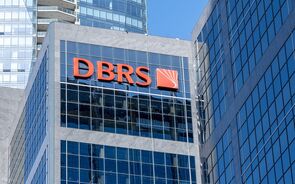13:30 - Dados States
2 mensagens
|Página 1 de 1
cont.
ECONOMIC REPORT: July Job growth slows to 32,000; Unemployment rate dips to 5.5%
By Rex Nutting, CBS.MarketWatch.com
Last Update: 8:31 AM ET Aug. 6, 2004
WASHINGTON (CBS.MW) -The U.S. economy added 32,000 nonfarm payroll jobs in July as hiring slowed for the fourth straight month, the Labor Department reported Friday.
It was the slowest job growth of the year.
Economists were expecting much stronger payroll growth of about 235,000 in July, according to a survey conducted by CBS MarketWatch.
Payroll growth in May and June was revised lower by a cumulative 61,000, showing the job market is weaker than commonly thought. June was revised to 78,000 from 112,000 while May was revised down to 208,000 from 235,000.
Meanwhile, a separate survey of households showed the unemployment rate fell to 5.5 percent from 5.6 percent. Economists had expected the jobless rate to remain steady. The household survey showed much greater strength in the job market than did the more-accepted survey of business establishments.
The report could have huge implications in financial markets, as well as on the campaign trail. The Federal Open Market Committee is widely expected to raise interest rates to 1.5 percent at its meeting on Tuesday, but the weakening job market could slow the pace of rate hikes later in the year if conditions don't improve.
President Bush has been touting his successes as an economic leader, while challenger John Kerry has argued that the benefits of growth have not been widely distributed.
In July, hiring slowed across most industries. Among 278 industries, 49.5 percent were adding jobs in July, down from 60.1 percent in June and the lowest percentage of the year.
Goods-producing industries added 18,000 including 10,000 in manufacturing. Construction firms added 4,000.
Services-producing industries added 14,000 jobs, the lowest since August 2003. Retail lost 19,000 jobs. Financial services lost 23,000.
Job growth was seen in professional and business services, which grew by 42,000 including 5,000 temporary help jobs. Health care and education added 20,000 jobs.
Government employment was flat.
The average workweek lengthened by a tenth of an hour to 33.7 hours from the record low 33.6 hours. Total hours worked in the economy increased by 0.3 percent after falling by 0.5 percent in June.
Average hourly earnings of nonsupervisory workers increased 5 cents, or 0.3 percent, to $15.70. Average weekly earnings increased by $3.25 to $529.09.
The separate household survey saw employment soar by 629,000 in July, while the labor force expanded by 577,000. Unemployment fell by 52,000 to 8.2 million.
The unemployment rate fell for most demographic groups. For whites, the jobless rate was 4.8 percent. For blacks, the jobless rate rose by 0.8 percentage points to 10.9 percent. For teenagers, the jobless rate was 17.6 percent.
Long-term unemployment dropped significantly. Of the 8.2 million classified as unemployed, 20.4 percent had been out of work longer than 27 weeks, down from 21.6 percent in June. The average duration of unemployment fell to 18.6 weeks from 19.9 weeks, with the median duration fell to 8.9 weeks from 10.8 weeks.
By Rex Nutting, CBS.MarketWatch.com
Last Update: 8:31 AM ET Aug. 6, 2004
WASHINGTON (CBS.MW) -The U.S. economy added 32,000 nonfarm payroll jobs in July as hiring slowed for the fourth straight month, the Labor Department reported Friday.
It was the slowest job growth of the year.
Economists were expecting much stronger payroll growth of about 235,000 in July, according to a survey conducted by CBS MarketWatch.
Payroll growth in May and June was revised lower by a cumulative 61,000, showing the job market is weaker than commonly thought. June was revised to 78,000 from 112,000 while May was revised down to 208,000 from 235,000.
Meanwhile, a separate survey of households showed the unemployment rate fell to 5.5 percent from 5.6 percent. Economists had expected the jobless rate to remain steady. The household survey showed much greater strength in the job market than did the more-accepted survey of business establishments.
The report could have huge implications in financial markets, as well as on the campaign trail. The Federal Open Market Committee is widely expected to raise interest rates to 1.5 percent at its meeting on Tuesday, but the weakening job market could slow the pace of rate hikes later in the year if conditions don't improve.
President Bush has been touting his successes as an economic leader, while challenger John Kerry has argued that the benefits of growth have not been widely distributed.
In July, hiring slowed across most industries. Among 278 industries, 49.5 percent were adding jobs in July, down from 60.1 percent in June and the lowest percentage of the year.
Goods-producing industries added 18,000 including 10,000 in manufacturing. Construction firms added 4,000.
Services-producing industries added 14,000 jobs, the lowest since August 2003. Retail lost 19,000 jobs. Financial services lost 23,000.
Job growth was seen in professional and business services, which grew by 42,000 including 5,000 temporary help jobs. Health care and education added 20,000 jobs.
Government employment was flat.
The average workweek lengthened by a tenth of an hour to 33.7 hours from the record low 33.6 hours. Total hours worked in the economy increased by 0.3 percent after falling by 0.5 percent in June.
Average hourly earnings of nonsupervisory workers increased 5 cents, or 0.3 percent, to $15.70. Average weekly earnings increased by $3.25 to $529.09.
The separate household survey saw employment soar by 629,000 in July, while the labor force expanded by 577,000. Unemployment fell by 52,000 to 8.2 million.
The unemployment rate fell for most demographic groups. For whites, the jobless rate was 4.8 percent. For blacks, the jobless rate rose by 0.8 percentage points to 10.9 percent. For teenagers, the jobless rate was 17.6 percent.
Long-term unemployment dropped significantly. Of the 8.2 million classified as unemployed, 20.4 percent had been out of work longer than 27 weeks, down from 21.6 percent in June. The average duration of unemployment fell to 18.6 weeks from 19.9 weeks, with the median duration fell to 8.9 weeks from 10.8 weeks.
-
Info.
13:30 - Dados States
8:29am 08/06/04 U.S. JULY NONFARM PAYROLLS 32,000 VS. 235,000 EXPECTED
8:29am 08/06/04 U.S. JULY AVERAGE HOURLY EARNINGS 0.3%
8:30am 08/06/04 U.S. JULY AVERAGE WORKWEEK UP TO 33.7 HOURS
8:30am 08/06/04 U.S. JULY AVERAGE WORKWEEK UP TO 33.7 HOURS
8:30am 08/06/04 U.S. JUNE PAYROLLS REVISED DOWN TO 78K VS. 112K
8:30am 08/06/04 U.S. JULY MANUFACTURING PAYROLLS UP 10,000
8:30am 08/06/04 U.S. JULY HOUSEHOLD SURVEY: 629,000 MORE HAVE JOBS
8:29am 08/06/04 U.S. JULY AVERAGE HOURLY EARNINGS 0.3%
8:30am 08/06/04 U.S. JULY AVERAGE WORKWEEK UP TO 33.7 HOURS
8:30am 08/06/04 U.S. JULY AVERAGE WORKWEEK UP TO 33.7 HOURS
8:30am 08/06/04 U.S. JUNE PAYROLLS REVISED DOWN TO 78K VS. 112K
8:30am 08/06/04 U.S. JULY MANUFACTURING PAYROLLS UP 10,000
8:30am 08/06/04 U.S. JULY HOUSEHOLD SURVEY: 629,000 MORE HAVE JOBS
-
Info.
2 mensagens
|Página 1 de 1
Quem está ligado:


